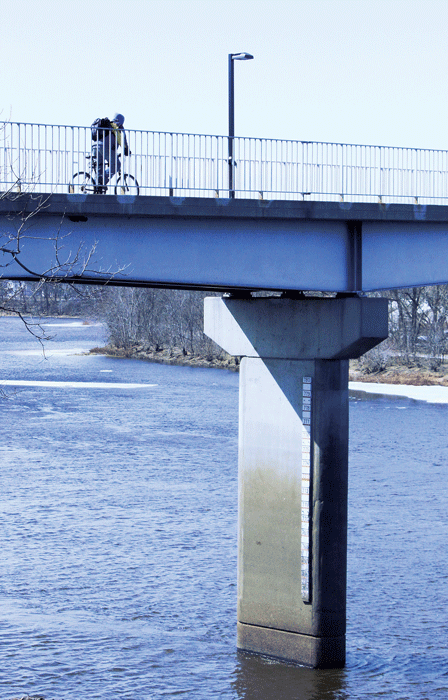Chippewa River not expected to flood
River currently at a normal elevation, caution should still be exercised around water
April 2, 2014
In the fall of 2010, the Chippewa River worked its way over its banks and flooded Owen Park, underpasses and parts of downtown. That was the last time the river has flooded, John Genskow, deputy city engineer of Drainage and Development said.
Eau Claire is not likely to see such flooding this spring, Genskow said. The river is just barely above normal in terms of elevation now.
For the river to be in flood stage, it must meet a gauge elevation of 773. On Monday, the Chippewa River was at a gauge elevation of 760.1 at Grand Avenue, according to the Department of Public Works.
Due to recent warm temperatures in the Chippewa Valley, the National Weather Service has revised the projection for the Chippewa River at Grand Avenue to crest Thursday afternoon at gauge elevation 770, according to the Department of Public Works.
Genskow said the National Weather Service could adjust the crest projection again since Monday was not as warm as forecasted in the areas that cause the river to rise.
“We are looking at warm days in Hayward and points north,” Genskow said. “Our warm days cause flooding problems down in Durand and La Crosse.”
Even though the river will not be at flood stage, as waters rise, the Chippewa River Trail behind the Hobbs Ice Center and behind the Haas Fine Arts Center, bridge underpasses at Madison Street, Farwell Street and Lake Street and lower parts of Owen Park will be underwater, Genskow said.
Matt McHugh, manager of Clear Water Real Estate, said the city has taken proper precautions to prevent as many significant floods as possible.
Clear Water Real Estate used to own properties on First Avenue between Niagara Street and Chippewa Street, which flooded regularly, McHugh said, but the city purchased the land in the 90s to try to reduce the amount of floods.
“We haven’t had a lot of problems in recent years,” McHugh said. “It would have to be a significant flood before our properties would be affected. Through the efforts of the city removing some problem properties, most of those problem areas have been addressed.”
McHugh said most problems they have been facing with their properties lately have been due to the wet summers and hard winters, which have been causing humidity problems in basements.
Mike Rindo, assistant chancellor for facilities and university relations, said whenever flooding is expected the university is always in very close communication with the city. The city regularly updates the university, he said.
The river isn’t at risk of flooding mainly due to the rate of melting, Rindo said.
“We had warm temperatures and now overnight temperatures are below freezing which slows the rate and draws it out over a longer length of time,” Rindo said.
The university takes preventative measures if there are any flooding problems, like a dam on little Niagara which starts to back up when the Chippewa River floods, he said.
“We do have a number of precautions to mitigate flooding or flooding effects. None of those have been triggered at this point,” Rindo said.
Genskow said the city is continually monitoring the river to know when they will have to close portions of trails throughout town, and in case anything changes with predicted flooding.
“If the river jumps higher than expected we want to be ready,” Genskow said.
Even if the river doesn’t flood people should still be cautious when using the rivers for boating, canoeing, kayaking, shore-side fishing, tubing, swimming, wading or activities near the water. Hazards involving high water levels, strong currents, floating or submerged wood debris or trees and obscured pilings are present on the Chippewa River, according to the Department of Public Works.

